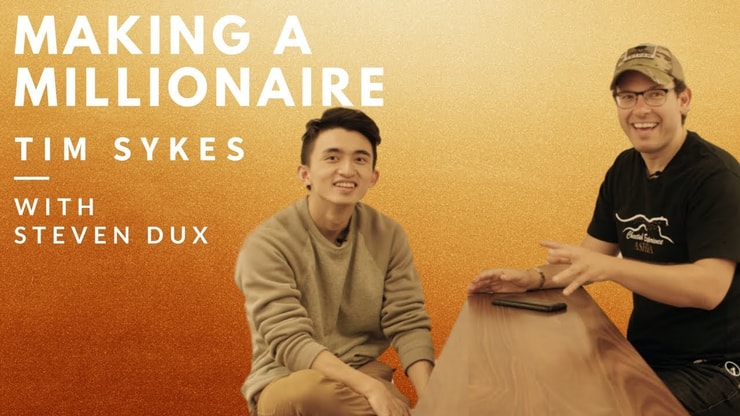Every time I do a video with my Millionaire Trading Challenge student Steven Dux, the video goes crazy…this was our first one that now has 500,000+ views:
end the month with 400k high note pic.twitter.com/omf246Uv1J
— stevendu (@Steven1_994) March 28, 2018
And now a second interview we did the other day is already very popular…so here it is and see the transcription below too for my valued deaf Trading Challenge students!
Tim: What’s up? Tim Sykes, millionaire mentor, and trader here with Steven Dux. Thanks for coming to Miami, dude.
Steven: Thank you.
Tim: Freaking awesome two days. We studied, we learned and we prepared yesterday. Today, you made how much?
Steven: 42,000.**
Tim: $42,000. Now, what are you up to in total profit?
Steven: 1.7.
Tim: 1.7.
Steven: 1.7 million.**
Tim: 1.7 million. I love it. All my top students they say like… You know, when Tim Grittani passed 1 million he’s like, “You know, I passed one.” You didn’t pass one, you passed 1 million. Tim Grittani is now closing in on 6 million. You’ve done all this in two years. What is your secret? Tell us, please.**
Steven: Tim Grittani learned from others and it actually accelerated up his learning curve, and I learned from Tim Grittani and you, of course, to speed up my learning curve. So that’s why my success rate is a little bit faster than others.**
Tim: By learning from other people, you can speed up your own learning curve is basically what you’re saying.
Steven: Yes.
Tim: And I agree. That’s the beauty of what I think my challenge is all about because you have the advantage of learning from me, Tim Grittani, Mark Crook, Michael Goode. We’re all making video lessons and webinars. How many webinars do you think you’ve watched?
Steven: Countless, at least 200, I’d say.
Tim: Yeah.
Steven: I can’t really remember the number. I watch them every day.
Tim: No, trust me, I see you’re studying. What do you think the biggest lesson that you encountered along the way is?
Steven: You have to learn how to be patient, how to not get emotional and always try to cut losses quickly.
Tim: Rule number one, always cut losses quickly. I might not have made $42,000 today and yesterday. Yesterday, I had one bad trade, but I made, I guess, roughly $3,000 between the past two days. So I’m a little more conservative. You’re a little more patient and aggressive. That’s fine. There’s different ways. Whether you make 3,000 in two days or 40,000 in two days, both are fantastic.**
Steven: It’s all profits.**
Tim: It’s all profits, right? So what do you think the toughest lesson for you has been?
Steven: Cutting losses quickly. I think that’s the toughest lesson.
Tim: Really?
Steven: Yeah.
Tim: So you just let it run sometimes?
Steven: Sometimes you’re emotional, says, “I’m gonna go into this trade,” and without any patterns, you are going because you want to go in. Then the stock turns against you and you have to keep adding and adding. That’s where the big losses come from.
Tim: What do you think most people, you know, a lot of people reach out to you, what do most people have issues with?
Steven: They can’t control their emotions because when they see a stock go up, they want to chase it. When they see a stock go down, they want to short it. But it happens the opposite. When a stock is going up, you tend to be shorting it because you’re looking to get a better entry. So control your emotions is the best…
Tim: Well, it’s counterintuitive too. In order to really succeed, you have to do the opposite of what you feel and that is so difficult, you know?
Steven: It’s very difficult because of the human nature.
Tim: It’s human nature, but all the best lessons. This is why I say in order to have patience to wait for the best trade. I think of myself as a retired trader. I’m a full-time trader. I’m a coach. I’m trading nearly every day, but I think of myself as, “No. I don’t need to trade. I’m only gonna come out of retirement if there is a trade that’s good enough, that will make me feel guilty that I’m retired.
Steven: Yeah. So you have to think of it that way too because when you miss an opportunity, you think you missed so much money but you can’t think that way. That way will destroy your account.
Tim: I would rather miss a trade than trade too much and take shitty trades.
Steven: Yes.
Tim: How do you overcome this? Teach us how to be patient.
Steven: To be patient, I think you need to practice. Second, you can’t be too rushed to make money, like nothing comes really fast.
Tim: Says the man who made nearly $2 million in two years.
Steven: I don’t think it’s that fast. Bitcoin is even faster.
Tim: Don’t bring up Bitcoin. That’s been the single biggest boom in the past two years. Tim Grittani was closing in on 6 million, made no money for nine months. Why did you make so much money when he made none? What is your secret?
Steven: Learn from Tim Grittani.
Tim: No, this is a great point. So Tim Grittani had me and Michael Goode to learn from. But you have Grittani, me, Michael Goode, and Mark Crook. So the more students. And now you know, other challenge students have you to learn from. So as we keep creating more and more success stories, your education gets easier because you have more different examples because we’re all slightly different.
Steven: Yes. So your speed curve is much faster, getting faster and faster.
Tim: Yes. What do you think is the best thing to do right now in 2018? Because the last time we talked, it was a different market. What’s different now?
Steven: Right now the market is very volatile. So there is a lot of opportunity out there and you don’t have to be rushed into the opportunities. Be patient, wait for the right opportunity to come, and go for it.
Tim: What do people do while they’re waiting? Because we have a lot of people with itchy fingers, like they want to make a trade, like their money is just sitting there, they want to get rich. What do you do when you’re not trading?
Steven: Well, when you’re trading, you have to understand what you’re doing. So learning while you are free. If you are waiting just pull up a video lesson, pull up a webinar, and watch and learn. It’s better to learn than lose money [inaudible 00:05:48].
More Breaking News
- Astera Labs Surge: What Could Be Fueling This Unexpected Rise?
- Joby Aviation Takes Off: Is the Air Taxi Market Ready for Transformation?
- ReAlpha Tech Corp’s Strategic Shift: Cryptocurrency Embrace and AI Homebuying Expansion
Tim: Do you hear this guy? I say this every day. Maybe with the soft-spoken accent, maybe that’s what it’s gonna take you to do it. My point is that when there’s no great play, most people are sad, right? They’re like, “Aw, there’s no great play.” And I say, “No, this is a good thing. This gives you more opportunity to study so that you can be better prepared for when the next play is there.”
Steven: I totally agree because when people are tired of waiting, there’s nothing happening in the market. If you are studying, you will be confident enough to go into the next play. And when you are more confident, you have more patience, then you gain more profits.
Tim: If there was a hot play right now, I would say that most people wouldn’t even be properly prepared to capitalize on it.
Steven: If you try to rush into it, you can’t profit from it.
Tim: Correct. So there might be a hot play right now and some newbie who hasn’t studied the DVDs and the webinars and the video lessons, “Okay. There’s a hot play. What do I do?” Because they’re not prepared. So our job is to prepare you ahead of time, right? That’s why we have so many DVDs and video lessons. That’s why you came out with your own guide now too.
Steven: So studying is the key.
Tim: Studying is the key as you always say. One other question… Actually, I got a question for you because I ask people, I’m like, “Oh, I’m gonna talk with Steven Dux.” Wait for this question. Let me see. This is from Mark in New Hampshire. Thank you for writing in, Mark. Steven…it’s a long question. “What is the best software to use for finding stocks?”
Steven: “StocksToTrade.”
Tim: There we go. I mean, there’s more to it. “What are the scans that you use,” he’s basically asking?
Steven: The only scan you need to use is just top percent gainer, finding the hottest stocks and the stock that everybody is watching.
Tim: But you use StocksToTrade.
Steven: Yes.
Tim: And I highly encourage you guys to do it because the big percent gainers are good, but we take it a step further. There’s 40 scans built into StocksToTrade.
Steven: Yes.
Tim: So, for me, I like using different ones. Like, the big percent gainers are good but also big percent gainers over three days or five days or you know, different things like that.
Steven: Yeah. But if you are in front of the market every single day, you’ll know what stock to trade.
Tim: But some people aren’t. You have to understand. So we have students all over and they have different you know, schedules. Some people can’t be in front of the markets every day.
Steven: Yeah. So you can create your own criteria to scan…
Tim: You can create your own criteria. Do you do that?
Steven: Yes.
Tim: How many different criteria do you use?
Steven: Not that many for scan only, but I use criterias for shorting stocks.
Tim: Yeah. But I find that simple works pretty well. Again, this is counterintuitive. Like, people are like, “Okay. There’s 500 indicators. Let me plug them all in.” I mean, if I used some of these indicators, I would just lose my mind.
Steven: Yeah. When you’re trading, you have to keep it as simple as possible for you to understand, not trying to be super complicated.
Tim: Do you know KISS, K-I-S-S, Keep it simple stupid?
Steven: Yeah.
Tim: It works really well. It really works in the stock market.
Steven: It does work, yes.
Tim: All right. One thing…we have to go, the market is gonna close in a little bit. I wanna get back just in case there’s any overnight plays. One tip for people watching this, your best tip. Aside from studying, aside from having patience, what’s your third tip? Because those are two big ones.
Steven: There’s lots of examples like us for people who are getting successful really quick. If you want to be successful, you have to work harder than us. So not many people can be successful. In trading, 8/10 people lose money.**
Tim: Or 9/10 depending on different studies.
Steven: Yeah. Or 9/10. So if you want to be better than us, you have to study hard. You have to follow the rules. You basically need to be better than us to get faster success.**
Tim: It’s true. And you have to learn the rules in order to follow them. A lot of people don’t know the rules, like what rules do you follow. That’s why we teach specific rules. It’s all about preparation and discipline, you know? You’re only as good as your trading plan. And if you have no trading plan, what are you gonna do? You’re probably not gonna do well. You might have a good trade. You might have a bad trade. A lot of it is luck. Would you say that you plan meticulously on every trade?
Steven: Yes. Every single trade I go in, I have a plan. I have my risk level. If it goes up, my risk level, I cut it. And when you cut it, you have a loss, but this loss you have to be really comfortable with. So trading and the stock market are like opportunities. If you take a loss, it’s acceptable because you know you will make it back, your winning percentage is there. Always trust yourself, be confident.
Tim: Thank you, sir. This guy is so incredible, check out his new guide, we’ll post the link just below this video. Learn the rules, learn patience, understand this is a marathon, not a sprint. You will not necessarily become a millionaire like this guy within two years. Some students take longer, and that’s fine. Think about… Oh, this is what I wanted to say. I’ve been saying this to a lot of students, let me know how it sounds. I say, “What can you do today and tomorrow, this week and next week and this month that will serve you well over a year from now or two years from now,” meaning if you make $1,000 today, it doesn’t matter a year from now. But if you make $1,000 on a trade today following a plan, and then you use that same plan with a bigger account a year from now, that $1,000 maybe a year from now might be a $10,000 profit. You scale up over time. Have you been scaling up?**
Steven: I don’t really scale in the market. I’ve been patient.
Tim: But from the beginning. Let’s go back to the beginning. When you first started, you were not taking the position sizes that you take now.
Steven: Yes.
Tim: So you got comfortable with the rules, you got comfortable with the patterns, and then once you found that comfort level, once you saw it working time and again, that’s when you felt more comfortable to take bigger positions.
Steven: Yes.
Tim: So don’t take big positions in the beginning. I would rather you paper trade on StocksToTrade or take small positions practicing honing your techniques.
Steven: You have to understand you can’t grow a bigger account when you can’t grow a small account.
Tim: Correct. Oh, my God. That is the best point. When you have a small account, focus on learning how to grow that small account. You’re not gonna go from 1,000 to 1 million all at once.** Try to go from 1,000 to 5,000, and then 5,000 to 10,000, and then 10,000 to 30,000, then 30,000 to 100,000. Then, once you have already proven yourself, you have the process down and you understand, it’s the same exact stuff, just with bigger positions later on. I think that’s actually a good thing, like for people to break it down because they see us like, “Oh, millionaires.” But you have to start small and then it can get bigger over time.**
Steven: Yeah, correct.
Tim: All right. We got to go trade. Thank you for tuning in. Cheers.
Steven: Thank you.
UPDATE: What a day for my top Trading Challenge students and I, SEVERAL of us made $2,000, $5,000, $10,000 even $100,000+ mainly on this classic pattern and of course Steven made six-figures mainly shorting GERN:
Update 2: Want more good reads like this? Check out:



Leave a reply